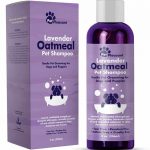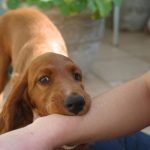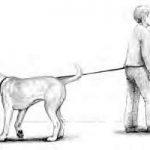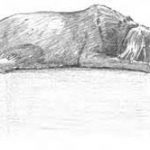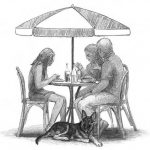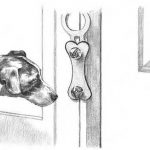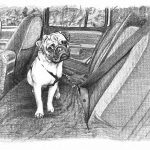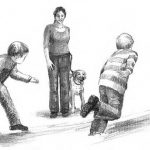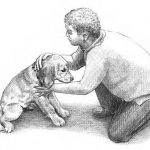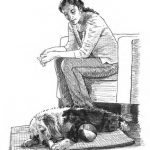Profiling the Sporting Group
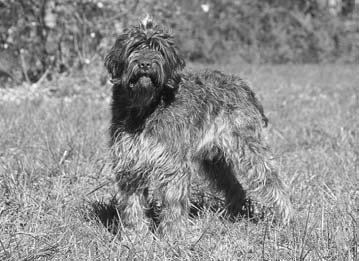

In This Chapter
- Getting to know the modern hunters
- Understanding the finer points of the breeds
- Choosing a breed that suits your lifestyle
- Learning to live with an energetic dog
The “sporting” in Sporting Dogs is less about soccer and baseball than it is about hunting. The dogs of the Sporting Group — the Pointers, Setters, Retrievers, and Spaniels — were bred to be active, alert, and athletic hunting companions. Their primary purpose: to search for and retrieve game. For some, this meant flushing small game out of brush; for others, it meant diving into icy waters to retrieve fallen waterfowl. The Sporting breeds are known as the modern hunters of the canine world because they accompanied hunters with guns rather than nets.
Thanks to supermarkets and convenience stores, today’s Sporting dogs are not a critical part of stocking the icebox. If you don’t hunt, you’ll need to divert your Sporting dog’s boundless energy in other directions. Consider jogging, field trials, brisk walks, play sessions, and obedience training as potential hunting alternatives. Because Sporting breeds typically are gentle, enthusiastic, and eager to please, they’re well suited to family life — as long as they get a good dose of strenuous exercise each day. Without it, you risk damage to your backyard and home.
If you’re happy to spend a weekend at home reading a good book or devoting an entire day to your model airplanes, a Sporting dog probably is not the breed for you. If, however, you and your dog can start the day with a good jog and then head out in the afternoon for a short hike, your companion will happily settle down at your feet for an evening of popcorn and the latest movie release. Sporting dogs are real social animals who were bred to enjoy working closely with people. Without their people, these breeds are not happy campers. Ever seen the look in a black Lab’s eyes as he waits for his owner to come out of a store? Dogs such as Spaniels and Retrievers crave interaction with humans and truly appear to suffer if ignored or left alone too long.
The Sporting breeds have long been admired for their instincts and skills in water and woods. This group is divided into four types: Pointers, Retrievers, Setters, and Spaniels. The breeds presented in this chapter are grouped according to these types, each with its own talents and physical characteristics. Pointers, Retrievers, and Setters are large; Spaniels run smaller. Retriever coats range from short to medium, and most Pointers have short hair (some are wiry). The Setters have long hair, and the Spaniels’ coats range from medium to long, some with gorgeous curls.
When you’re not out hiking or hunting with your Sporting breed, you may find a fenced yard to be a useful part of satisfying your dog’s need for fresh air and room to explore. Even better, head out there for a game of catch or fetch. You’ll be amazed at how long your dog is capable of playing; Retrievers, in particular, are perfectly happy to fetch sticks, balls, Frisbees, and so forth for you until your arm is numb.
Brittany
History/Evolution: Named for the French province where it originated around 1900, the Brittany may have been the result of crosses between native Brittany Spaniels and English pointing dogs. A fine hunter with a strong nose, the Brittany became popular in France, arriving in the U.S. in 1925. Equally suited for sport and companionship, the Brittany’s popularity has surged. Originally called the Brittany Spaniel, the “Spaniel” was dropped in 1982 because the breed’s hunting style is more like a Setter than a Spaniel.
Size: Medium; 171⁄2 inches to 201⁄2 inches, 30 to 40 pounds.
Color: Orange and white, liver and white (white can be clear or roan).
Temperament: Alert, quick, and curious; loves to run and play. Independent but responsive, eager to please, affectionate. A good house pet if given mental and physical exercise.
Energy level: High.
Best owner: Hunter, an active family in a suburban or rural home.
Needs: Abundant and daily exercise (runs, obedience), fenced yard, regular brushing once or twice a week.
Life expectancy: 12 to 13 years.
Photograph © Jean Fogle
Pointer
History/Evolution: Though unclear, the Pointer’s lineage likely can be linked to Greyhounds, Foxhounds, Bloodhounds, and a type of setting Spaniel. Pointers were first used in the mid-1600s in England to point hares for Greyhound coursing. Pointers later became popular for recreational bird hunting and, in the 19th century, as show dogs. Today’s Pointers still have the stamina, determination, and skill of capable hunters, but are also treasured as family dogs and companions.
Size: Large; females 23 to 26 inches, 35 to 65 pounds; males 25 to 28 inches, 55 to 90 pounds. (Field-trial lines tend to be smaller than show lines.)
Color: Liver, lemon, black, orange; all with or without white.
Temperament: Alert, independent, and dignified. Happiest with a job (obedience, agility, field trials); can be destructive if not exercised enough. Exuberant but tolerant of children.
Energy level: Medium to high.
Best owner: Hunter or active, outdoorsy owner.
Needs: Vigorous physical and mental exercise every day, fenced yard, plenty of outside time, companionship, regular brushing.
Life expectancy: Field lines 10 to 12 years; show lines 12 to 14 years.
Photograph © Jean Fogle
German Shorthaired Pointer
History/Evolution: Various scent and track breeds were crossed to produce what became the German Shorthaired Pointer in the late 1800s. Proficient with trailing, retrieving, and pointing game of many varieties, the German Shorthaired Pointer eventually became known as an ideal all-purpose hunting dog. First recognized by the AKC in 1930, the breed remains a gifted hunter as well as a loyal, obedient companion.
Size: Medium; females 21 to 23 inches, 45 to 60 pounds; males 23 to 25 inches, 55 to 70 pounds.
Color: Liver, liver and white ticked, spotted or roan.
Temperament: Intelligent, active, enthusiastic about hunting. Devoted, friendly, and willing to please. Playful and loving, but can be too boisterous for small children.
Energy level: High.
Best owner: Hunter or active family in a suburban or rural home.
Needs: Consistent exercise and mental stimulation to prevent boredom and destructive behaviors, gentle training, fenced yard, minimal brushing.
Life expectancy: 14 to 16 years.
Photograph © Jean Fogle
German Wirehaired Pointer
History/Evolution: With traces of Griffon, Pointer, German Shorthair, and Poodle, the German Wirehaired Pointer is an accomplished and versatile hunter. Able to withstand weather and water, the German Wirehaired can point and track game, retrieve waterfowl from water or land, and serve as a reliable guard dog. Recognized by the AKC in 1959, the breed enjoys moderate popularity in the United States, but not nearly as much as it has in its native Germany.
Size: Medium to large; females smaller, but not less than 22 inches; males 24 to 26 inches.
Color: Solid liver, liver and white; may have spots, roaning, and ticking.
Temperament: Energetic, rugged, independent, and driven. Prone to boredom and destructiveness if not physically and mentally challenged. Loyal and affectionate; aloof and protective, but not unfriendly to strangers.
Energy level: Medium to high.
Best owner: Active, outdoor-oriented person.
Needs: Regular exercise or a job to do, training, fenced yard, human companionship, minimal grooming.
Life expectancy: 12 to 14 years.
Photograph © Jean Fogle
Chesapeake Bay Retriever
History/Evolution: The Chesapeake Bay Retriever’s history begins in 1807 in Maryland with the arrival of two Newfoundlands who were rescued from an English brig shipwrecked off the coast. Crossings with various retrievers and others eventually produced the Chessie, a breed that excels at retrieving waterfowl both on land and in water. The Chesapeake Bay Retriever’s reputation later spread beyond the Bay, and the AKC recognized the breed in 1885. The Chessie is a true working dog who requires a master who is a skilled trainer.
Size: Large; females 21 to 24 inches, 55 to 70 pounds; males 23 to 26 inches, 65 to 80 pounds.
Color: Brown, from straw to reddish sedge.
Temperament: Hardy, intelligent, and active, with a love of water. Independent but eager to learn. Strong willed and protective; reserved with strangers.
Energy level: Medium to high.
Best owner: Active owner, outdoorsy family with considerate children.
Needs: Daily exercise (swims are preferred), early socialization, obedience training, fenced yard, weekly brushing of oily coat.
Life expectancy: 10 to 12 years.
Photograph © Jean Fogle
Curly-Coated Retriever
History/Evolution: One of the oldest of the Retrievers, the Curly-Coated Retriever is believed to have roots in such breeds as the English Water Spaniel, a smaller Newfoundland, and the Poodle, from which it gets its tightly curled coat. Developed in England to be a multipurpose hunting Retriever, the Curly is favored for its excellent field ability, endurance, and courage. Unsurpassed in the water, the Curly-Coated makes a fine family companion when challenged with exercise and activity.
Size: Medium to large; 22 to 27 inches, 55 to 75 pounds.
Color: Black or liver.
Temperament: Eager, self-confident, and steadfast; determined in the field, sensitive at home. Independent; sometimes appears aloof or self-willed.
Energy level: High.
Best owner: Hunter or active, outdoorsy owner in suburban or rural home.
Needs: Daily exercise (swimming and retrieving are best) and training to prevent boredom (and undesirable behaviors), fenced yard, companionship, and occasional combing.
Life expectancy: 8 to 12 years.
Photograph © Isabelle Francaise
Flat-Coated Retriever
History/Evolution: The Flat-Coated Retriever’s history can be traced to the 1800s, to dogs who served fisherman by retrieving fish and objects from the cold waters of Newfoundland. Crosses with these Retrievers and British Setters and Pointers eventually led to the Flat-Coated, which had the skills of both water dogs and bird dogs. Originally suited for hard work in the field, the Flat-Coated is an enthusiastic competitor and family member.
Size: Medium to large, 60 to 70 pounds; females 22 to 231⁄2 inches; males 23 to 241⁄2 inches.
Color: Black, liver.
Temperament: Lively, sweet, eager to please, outgoing, and playful; one of the most devoted breeds. Known for its ever-wagging tail. Determined in the field, with a great desire to hunt.
Energy level: High.
Best owner: Hunter, athlete, or active family.
Needs: Vigorous exercise and mental challenges (agility and obedience), fenced yard, early and consistent training, family bonding, occasional brushing and bathing.
Life expectancy: 10 years.
Photograph © Jean Fogle
Golden Retriever
History/Evolution: The Golden Retriever was developed in Scotland in the late 1800s as a hunting dog. Lord Tweedmouth, who wanted a Retriever suited to the Scottish terrain and climate, is credited with the breed’s beginnings. The Golden’s popularity grew, and the breed was brought to the United States in the 1920s. Although the breed is still valued for its hunting abilities, its intelligence, beauty, and eager-to-please attitude has made it one of the top breeds in the U.S.
Size: Medium; females 211⁄2 to 221⁄2 inches, 55 to 65 pounds; males 23 to 24 inches, 65 to 75 pounds.
Color: All shades of gold, from pale to rich reddish gold.
Temperament: Friendly, devoted, and obedient; eager to please as a family companion, with excellent rapport with children. Active and boisterous; needs exercise and activity.
Energy level: Medium to high; field lines higher than show lines.
Best owner: Active, social family in suburban or rural home.
Needs: Daily physical and mental exercise (games, retrieving, obedience), human interaction, fenced yard, twice-weekly brushing.
Life expectancy: 10 to 14 years.
Photograph © Jean Fogle
Labrador Retriever
History/Evolution: Originally from Newfoundland in the 1800s, Labs were bred to work with fisherman to pull nets and retrieve fish. Later the dogs were honed to be game retrievers. Although black Labs were initially preferred, chocolate and yellow were accepted by the early 1900s. The breed’s intelligence and adaptability has propelled it into such canine careers as guide dog, search and rescue, and police work. Extremely gentle and eager to please, the Lab is incredibly appealing as a pet and remains the most popular breed in the U.S.
Size: Large; females 211⁄2 to 231⁄2 inches, 55 to 70 pounds; males 221⁄2 to 241⁄2 inches, 65 to 80 pounds.
Color: Black, yellow, and chocolate.
Temperament: Outgoing, amiable, gentle, and obedient; nonaggressive toward all. Intense in the field, but calm and playful as a home companion; patient with kids.
Energy level: High, especially in puppyhood.
Best owner: Active owner or family in suburban or rural home.
Needs: Daily physical and mental challenges to stay occupied (and avoid pudginess), obedience training, secure fencing (around yards and pools), weekly brushing.
Life expectancy: 10 to 12 years.
Photograph © Jean Fogle
Nova Scotia Duck Tolling Retriever
History/Evolution: The smallest of the retrievers, the Nova Scotia Duck Tolling Retriever was developed in the 1800s to toll and retrieve waterfowl. Tolling — having dogs play and retrieve sticks or balls along the shoreline — aroused the curiosity of ducks offshore and lured them within gunshot range. The first Tollers arrived in the U.S. in 1984, and the AKC recognized the breed in 2001. Since their arrival, the dogs have proven themselves as able retrievers, skilled competitors, and loyal companions.
Size: Medium; females 17 to 20 inches, 35 to 42 pounds; males 18 to 21 inches, 45 to 52 pounds.
Color: Any shade of red, usually with white markings.
Temperament: Energetic, playful, alert, outgoing, ready for action; fast learners but bored easily. Affectionate and gentle; boisterous when young. Good with other animals and children.
Energy level: High.
Best owner: Active owner or family in a suburban or rural home.
Needs: Lots of exercise, play, and activity; a job to do, fenced yard, weekly brushing.
Life expectancy: 11 to 13 years.
Photograph © Isabelle Francaise
English Setter
History/Evolution: With a history going back 400 years, the English Setter is one of the oldest gundog breeds. Likely developed from Spaniels, the breed would find birds and crouch down or “set,” allowing the hunter to (before guns) throw a net over the catch. Breeders developed the English Setter into two types: the Laverack (show setters) and the Llewellin (field setters). An elegant and accomplished Sporting dog, the English Setter is also a fine show dog, agility competitor, therapy dog, and companion.
Size: Medium to large; females 24 inches, 50 to 55 pounds; males 25 inches, 60 to 65 pounds.
Color: Orange, blue, lemon, or liver belton (white background with colored flecks or roan shading), tricolor.
Temperament: Athletic and energetic; a calm housedog with enough exercise. Gentle, affectionate, and laid back; exuberant, but good with children. Thrives on human contact, though not a good obedience student.
Energy level: High.
Best owner: Active owner or family with a suburban or rural home.
Needs: Vigorous daily exercise (hard runs), fenced yard, companionship, brushing every two to three days (with occasional clipping and trimming).
Life expectancy: 10 to 12 years.
Photograph © Jean Fogle
Gordon Setter
History/Evolution: The Gordon Setter’s origins can be traced to the 17th century in Scotland; its name comes from the fourth Duke of Gordon, who kept many of the dogs at his castle. Known at times as the Gordon Castle Setter and the Black and Tan Setter, the breed is the heaviest of the three setters. Hunters favored the sturdy and muscular Gordon for its bird-setting and retrieving skills. Though not as popular a pet as the other setters, the Gordon is a lively and devoted companion that thrives on exercise and love.
Size: Large; females 23 to 26 inches, 45 to 70 pounds; males 24 to 27 inches, 55 to 80 pounds.
Color: Black with tan (mahogany or chestnut) markings.
Temperament: Intelligent, fearless, and capable bird dog. Alert, energetic, and enthusiastic; devoted to family. Can get bored or frustrated without enough exercise and activity.
Energy level: High, calmer when mature.
Best owner: Athletic, confident owner.
Needs: Daily exercise (a 3-mile walk plus a short run), fenced yard, firm and consistent obedience training, human interaction, daily brushing to prevent mats.
Life expectancy: 10 to 12 years.
Photograph © Jean Fogle
Irish Red and White Setter
History/Evolution: Although the Irish Red and White Setter is rare in the U.S., recognized by the AKC only in 2007, the breed has a long history that began in 17th-century Ireland. A valuable hunting dog and companion, the breed was known for its power and skill in the field. Thought to be the older of the two Irish Setters, the Red and White’s popularity was eclipsed by that of the solid-red Irish Setter. It faced extinction by the end of the 1800s, but devotees revived the breed in the early part of the 1900s.
Size: Large, 50 to 75 pounds; females 221⁄2 to 24 inches; males 241⁄2 to 26 inches.
Color: White with solid red patches.
Temperament: Friendly, spirited, determined; can be high strung without proper exercise. Good with children.
Energy level: High.
Best owner: Hunter, active owner in a suburban or rural home.
Needs: Daily exercise (long walks or off-leash runs); fenced yard; early, firm, and consistent training; brushing two to three times a week.
Life expectancy: 11 to 15 years.
Photograph © Isabelle Francaise
Irish Setter
History/Evolution: A probable blend of spaniels, pointers, and other setters, the Irish Setter was developed by Irish hunters who needed a skilled bird-setting and retrieving dog large enough to be seen from a distance. Originally bred as red and white, the solid red of the Irish Setter gained favor in the 1800s. The breed’s elegant, striking looks have made it a champion in the show ring; its good-natured attitude and clownish personality have made it a beloved companion.
Size: Large; females 25 inches, 60 pounds; males 27 inches, 70 pounds.
Color: Mahogany or chestnut red.
Temperament: Tireless hunter and an amiable companion if exercised enough. Rollicking personality, full of gusto, eager to please. Good with children, but may be a bit rambunctious for toddlers.
Energy level: High.
Best owner: Active owner or family in a suburban or rural home.
Needs: Lots of exercise (minimum one hour of exertion a day), a social life, brushing every two to three days, consistent and gentle training methods, fenced yard.
Life expectancy: 12 to 14 years.
Photograph © Jean Fogle
American Water Spaniel
History/Evolution: The history of the American Water Spaniel is something of a mystery, but the breed is likely a product of ancestors that include the Irish Water Spaniel and the Curly-Coated Retriever. Developed in the mid-1800s in the Great Lakes region of the U.S., the American Water Spaniel was, and is, a remarkable hunting companion, the first American breed that could retrieve from boats. Although the AKC recognized the breed in 1940, it is still uncommon in the show ring or the home. It’s the state dog of Wisconsin.
Size: Medium, 15 to 18 inches; females 25 to 40 pounds; males 30 to 45 pounds.
Color: Solid liver, brown, or dark chocolate.
Temperament: Intelligent, friendly, and fun loving; a good family dog if given enough exercise (if not, prepare for barking and digging). Whining and drooling can be a problem.
Energy level: High, calmer when mature.
Best owner: Hunter of upland birds or waterfowl, active family in suburbs or country.
Needs: Daily exercise (swims are appreciated), fenced yard, human attention, short obedience sessions, weekly brushing, attention to ears (clean regularly).
Life expectancy: 10 to 15 years.
Photograph © Isabelle Francaise
Clumber Spaniel
History/Evolution: One of the oldest of the Spaniels, the Clumber dates back to 18th-century France and counts the Basset Hound and the Alpine Spaniel among its ancestors. The breed was valued for its low build, quiet nature, and slow gait, which helped it approach game very closely. English nobility favored the breed and discouraged its popularity with commoners. Although the Clumber is one of the original nine breeds recognized by the AKC, it remains generally unknown to the public.
Size: Medium; females 17 to 19 inches, 55 to 70 pounds; males 18 to 20 inches, 70 to 85 pounds.
Color: White with lemon or orange markings.
Temperament: Gentle, affectionate, and devoted; the most low key of the spaniels. Intelligent and independent; may be aloof with strangers.
Energy level: Medium.
Best owner: Hunter, social family in suburban or rural home.
Needs: Daily exercise (long walk or leisurely hike), fenced yard, positive training, tolerance for shedding and drool, brushing two to three times a week.
Life expectancy: 10 to 12 years.
Photograph © Isabelle Francaise
Cocker Spaniel
History/Evolution: The American Cocker Spaniel is derived from the English Cocker Spaniel, which was brought to the United States in the late 1800s. Wanting a smaller dog for small game birds such as quail, breeders likely crossed the English Cocker and smaller dogs to produce the American version; the two varieties were separated into two breeds in 1946. Although few hunt with the Cocker today, the breed — one of the most popular of all time — is a favorite at shows and treasured as a pet.
Size: Small, 24 to 28 pounds; females 14 inches; males 15 inches.
Color: Solids — black, black and tan, silver, buff, red, chocolate, chocolate and tan; parti-color — black and white, red and white, chocolate and white, tricolor.
Temperament: Merry, jovial, playful; a social dog who loves family. A true Sporting dog, but hunting instincts can be satisfied with a walk in the country. Some bark a lot.
Energy level: Medium to high.
Best owner: Loving owner with a penchant for hair care.
Needs: Daily exercise, a social life, almost daily brushing, clipping every month or so, special attention to eye and ear care.
Life expectancy: 10 to 14 years.
Photograph © Isabelle Francaise
English Cocker Spaniel
History/Evolution: The English Cocker Spaniel is one of the oldest land Spaniels, a descendant of the original spaniels of Spain. In the 1800s, the Spaniels were divided based on size and hunting ability. The English Cocker, a small land Spaniel, was used to hunt woodcock. Fanciers worked to differentiate the English Cocker from the American type that was gaining recognition; the two breeds were accepted as separate breeds in 1946. Today the English Cocker is an active Sporting dog and loyal companion.
Size: Medium; females 15 to 16 inches, 26 to 32 pounds; males 16 to 17 inches, 28 to 34 pounds.
Color: White with black, blue, liver, or red markings with roaning or ticking; solid black, liver, or red with or without tan markings.
Temperament: Affectionate, cheerful, and devoted; sociable and likes its humans. More of a hunter than the American Cocker Spaniel and needs a bit more exercise.
Energy level: High as a puppy, medium as matures.
Best owner: Active, social person or family.
Needs: Daily exercise, socialization, consistent brushing and combing, monthly clipping, special attention to eye and ear care, companionship.
Life expectancy: 12 to 15 years.
Photograph © Jean Fogle
English Springer Spaniel
History/Evolution: English Springer Spaniels and Cocker Spaniels were originally born in the same litters, and not until 1902 did the English Kennel Club separate the breeds. English Springers, the larger of the two, were used in the field for flushing or “springing” animals in hiding. The Springer Spaniel continues to thrive, gaining popularity with hunters as a versatile, vigorous gundog who can both flush and retrieve game. Many consider the breed to be the ideal family canine companion.
Size: Medium; females 19 inches, 40 pounds; males 20 inches, 50 pounds.
Color: Black and white, liver and white, or tricolor; may have ticking.
Temperament: Cheerful, playful, and energetic; affectionate and devoted to family. Good as a house pet if outlets for energy are provided.
Energy level: Medium-high.
Best owner: Active owner in a suburban or rural home.
Needs: Daily mental and physical exercise (hunting preferred, but obedience sessions and field outings will do), fenced yard, twice-weekly brushing plus clipping every couple months.
Life expectancy: 12 to 14 years.
Photograph © Jean Fogle
Field Spaniel
History/Evolution: Originating in England in the mid-1800s, the Field Spaniel shares its beginnings with the Cocker Spaniel but was deemed a separate breed in 1892. The long-eared Spaniel survived misdirected breeding efforts that nearly brought it to the point of extinction. Dedicated breeders revived the breed in the mid-1950s, honing not only its looks, but its hunting abilities. Though admired for its level headedness, the Field Spaniel remains one of the rarest breeds in the U.S.
Size: Medium, 35 to 50 pounds; females 17 inches; males 18 inches.
Color: Black, liver, golden liver, roan.
Temperament: Cheerful, affectionate, fun loving, and willing to please. Independent, but happy to have human companionship and a job. May be reserved with strangers.
Energy level: High.
Best owner: Hunter, active owner with training experience.
Needs: Daily exercise, fenced yard, human companionship, inclusion in family activities, weekly brushing, tolerance of sloppiness (eating and drinking) and shedding.
Life expectancy: 10 to 12 years.
Photograph © Isabelle Francaise
Irish Water Spaniel
History/Evolution: The largest Spaniel, the Irish Water is an interesting blend of several dogs: a Poodle-like coat, a Retriever’s fetching instincts, a Spaniel’s affectionate nature, and a Sporting dog’s love of water. The Irish Water Spaniel has a smooth face framed with curls and its body covered in dense, water-repellent ringlets, ending with a signature “rat tail.” An adept water retriever, the breed entered the American and British show rings in the late 1800s. Though popular for a time, the Irish Water Spaniel is relatively rare these days.
Size: Medium; females 21 to 23 inches, 45 to 58 pounds; males 22 to 24 inches, 55 to 65 pounds.
Color: Liver.
Temperament: Energetic, enthusiastic, even clownish. Can be independent and stubborn; needs patient, firm training. Alert and inquisitive; reserved with strangers.
Energy level: High as puppy.
Best owner: Hunter, outdoorsy type.
Needs: Daily mental and physical exercise (runs, strenuous play, obedience sessions), brushing and combing two times a week, scissoring every few months.
Life expectancy: 10 to 12 years.
Photograph © Isabelle Francaise
Sussex Spaniel
History/Evolution: The Sussex Spaniel owes it name to the kennel in Sussex, England, that was an important part of the breed’s development in the early 1800s. This small land Spaniel, though not as fast as others of its type, had a good nose and was skilled at working through dense underbrush. Unfortunately, the breed’s popularity with hunters was short lived, and the Sussex came close to extinction during the 1900s. Still rare, the Sussex is treasured by people who appreciate its lovely coat and deceptively somber expression.
Size: Small to medium; 13 to 15 inches, 35 to 45 pounds.
Color: Rich golden liver.
Temperament: Cheerful, and mellower than other spaniels. Calm in the home, but may bark or howl if left out of activities. Fine with animals and children.
Energy level: Medium.
Best owner: Family or owner in a suburban or rural home.
Needs: Daily exercise (a walk or backyard romp), fenced yard, human attention, obedience training, early socialization, brushing two to three times a week.
Life expectancy: 11 to 12 years.
Photograph © Isabelle Francaise
Welsh Springer Spaniel
History/Evolution: The exact origins of the Welsh Springer Spaniel are unclear, but the breed likely was developed around the 1600s in Wales. The breed enjoyed a rise in popularity as a hunting dog of the nobility but lost footing as the English Springer and other Spaniels came into favor. Brought to the U.S. in the late 1800s, the Welsh Springer gained AKC recognition in 1906. The breed is an accomplished all-purpose, all-terrain hunter that excels beyond the field into the show ring and home.
Size: Medium, 35 to 45 pounds; females 17 to 18 inches; males 18 to 19 inches.
Color: Red and white.
Temperament: Active, steady, easygoing. Loyal, affectionate, and totally devoted to family, but independent; reserved with strangers. Usually gentle with children.
Energy level: High as puppy, mellows with age.
Best owner: Active, loving owner in a suburban or rural home.
Needs: Daily exercise (long walks and strenuous games), socialization, fenced yard, weekly brushing, and occasional trims with scissors.
Life expectancy: 12 to 14 years.
Photograph © Jean Fogle
Spinone Italiano
History/Evolution: The Spinone Italiano’s origins are somewhat mysterious, although most experts credit the Piedmonte district of northwest Italy with its development. Theories abound; some link the dog to coarse-haired Italian Setters, dogs left behind by Greek traders, and even French Griffons. Italy’s all-purpose hunting dog, the Spinone Italiano is an excellent retriever that can hunt on any terrain. Although popular in Italy and some other European countries, it has not taken off in the U.S.
Size: Large; females 22 to 25 inches, 70 to 80 pounds; males 23 to 27 inches, 80 to 90 pounds.
Color: White, orange and white, orange roan, chestnut and white, chestnut roan.
Temperament: Gentle, devoted, eager to please, and affectionate; cautious about new people and situations, but good with children. Calmer than most pointing breeds.
Energy level: Medium.
Best owner: Hunter, athletic owner in suburban or rural home.
Needs: Daily exercise (long walk or off-leash run), fenced yard, socialization, training, weekly brushing and occasional hand stripping, tolerance of messy beard.
Life expectancy: 12 to 14 years.
Photograph © Isabelle Francaise
Vizsla
History/Evolution: The Vizsla’s history can be traced to Hungary in the Middle Ages. The country was rich in game, and the Vizsla’s superior nose, speed, and hunting ability met the needs of the hunters. The breed excelled at both pointing and retrieving and was a favorite of barons and warlords by the 1700s. Although the Vizsla’s numbers declined by the end of the World Wars, devotees worked to reestablish the breed; the AKC recognized the Vizsla in 1960.
Size: Medium, 45 to 65 pounds; females 21 to 23 inches; males 22 to 24 inches.
Color: Golden rust.
Temperament: Lively, active, highly trainable; a natural hunter. Gentle, affectionate. Well-developed protective instinct. Can be frustrated and destructive without enough exercise.
Energy level: High.
Best owner: Hunter, athlete, or active family in suburbs or country.
Needs: Strenuous daily exercise (long runs), fenced yard, lots of outdoor activity with its family, regular brushing to control shedding.
Life expectancy: 12 to 15 years.
Photograph © Jean Fogle
Weimaraner
History/Evolution: Developed in Germany in the 19th century, the Weimaraner is believed to be a descendant of the Bloodhound and early
pointing breeds. Originally bred to be an all-around
gundog who could hunt wolves, deer, and bear, the Weimaraner later transitioned to more of a bird dog and hunting companion. The distinctly gray dogs were highly valued, and breeding was strictly managed to keep lines pure. Not until 1929 did the first Weimaraners leave Germany, when an American was allowed to bring two to the U.S.
Size: Large; females 23 to 25 inches, 50 to 70 pounds; males 25 to 27 inches, 70 to 85 pounds.
Color: Mouse gray to silver gray.
Temperament: Friendly, fearless, and obedient; can be stubborn or headstrong, but learns easily. Needs to run and hunt. Good with children, but may overwhelm little ones.
Energy level: Very high.
Best owner: Hunter or outdoorsy, confident owner.
Needs: Serious daily exercise, fenced yard, human companionship, obedience training, brushing.
Life expectancy: 10 to 12 years.
Photograph © Jean Fogle
Wirehaired Pointing Griffon
History/Evolution: The history of the Wirehaired Pointing Griffon begins in the mid-1880s. Eduard Korthals of Amsterdam is credited with developing the breed, which he hoped would be a dog who could hunt in marshes and other terrain. He took the dog to France, where it was well received and quickly gained a following. Known for a time as the Russian Setter, the Griffon gained AKC recognition in 1887. Today the breed still has loyal followers who value it for its pointing and retrieving as well as for its companionship.
Size: Medium to large, 50 to 60 pounds; females 20 to 22 inches; males 22 to 24 inches.
Color: Chestnut, solid or with roaning.
Temperament: Skilled, independent field dog, easily trained. Outgoing, eager to please, comical, and amiable in the home with enough exercise. Generally friendly toward others.
Energy level: Medium to high.
Best owner: Hunter, athletes in suburban or rural home.
Needs: Daily exercise (jogging, field runs, games), fenced yard, consistent training, weekly brushing and some hand stripping, attention to ear care.
Life expectancy: 12 to 14 years.
Photograph © Jean Fogle
by Eve Adamson, Richard G. Beauchamp, Margaret H. Bonham, Stanley Coren, Miriam Fields-Babineau, Sarah Hodgson, Connie Isbell, Susan McCullough, Gina Spadafori, Jack and Wendy Volhard, Chris Walkowicz, M. Christine Zink, DVM, PhD



























